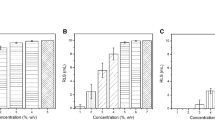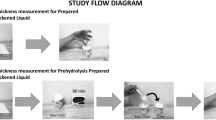Abstract
Children with dysphagia, or swallowing disorder, are at an increased risk for developing respiratory compromise, failure to thrive, and aversion. Thickened liquids can be recommended for children with dysphagia, if shown to be effective on instrumental examination and if strategies/interventions with thin liquids are not successful. Thickened liquids have many benefits, including creating a more cohesive bolus, slowing oropharyngeal transit time, and reducing aspiration. However, preparing thickened liquids with commercially available thickeners can result in poor compliance due to concerns regarding taste, texture, accessibility, cost, thickness variability, and potential negative impact of these substances on a child’s immature digestive tract. The purpose of this study was to determine if liquids could be successfully thickened with widely available, commercial pureed foods, and to assess how these mixtures compare to starch and gum based thickening agents. The International Dysphagia Diet Standardisation Initiative (IDDSI) flow test was performed for each sample of puree thickened liquids, gum based thickened water, and cornstarch based thickened water. In addition, rheology testing was performed on each category of the samples to measure viscosity at various shear rates and temperatures, and to assess the presence of yield stress. Results revealed that liquids thickened with smooth textured purees were comparable to commercial starch and gum based thickeners, and may be offered as a viable alternative.



Similar content being viewed by others
References
Lefton-Greif MA. Pediatric dysphagia. Phys Med Rehabil Clin N Am. 2008;19(4):837–51.
Martin-Harris B, Brodsky MB, Michel Y, Castell DO, Schleicher M, Sandidge J, Maxwell R, Blair J. MBS measurement tool for swallow impairment—MBSImp: establishing a standard. Dysphagia. 2008;23(4):392–405.
Arvedson JC. Management of pediatric dysphagia. Otolaryngol Clin North Am. 1998;31(3):453–76.
Coyle JL, Davis LA, Easterling C, Graner DE, Langmore S, Leder SB, Lefton-Greif MA, Leslie P, Logemann JA, Mackay L, Murray JT, Sonies B, Steele CM, Martin-Harris B. Oropharyngeal dysphagia assessment and treatment efficacy: setting the record straight (response to Campbell-Taylor). J Am Med Dir Assoc. 2009;10(1):62–6.
Gurberg J, Birnbaum R, Daniel SJ. Laryngeal penetration on videofluoroscopic swallowing study is associated with increased pneumonia in children. Int J Pediatr Otorhinolaryngol. 2015;79(11):1827–30.
Brooks L. Treatment for Dysphagia. In: Ongkasuwan J, Chiou EH, editors. Pediatric Dysphagia: challenges and controversies. Cham: Springer; 2018. p. 147–61.
Tutor JD, Gosa MM. Dysphagia and aspiration in children. Pediatr Pulmonol. 2012;47(4):321–37.
Simon M, Collins MS. The pediatric lung and aspiration. SIG 13 Perspect Swal Swal Disord (Dysph). 2013;22(4):142–54.
Matsuo K, Palmer JB. Anatomy and physiology of feeding and swallowing: normal and abnormal. Phys Med Rehabil Clin N Am. 2008;19(4):691–707.
Weckmueller J, Easterling C, Arvedson J. Preliminary temporal measurement analysis of normal oropharyngeal swallowing in infants and young children. Dysphagia. 2011;26(2):135–43.
Cichero JA. Thickening agents used for dysphagia management: effect on bioavailability of water, medication and feelings of satiety. Nutr J. 2013;12(1):54.
Kuhlemeier KV, Palmer JB, Rosenberg D. Effect of liquid bolus consistency and delivery method on aspiration and pharyngeal retention in dysphagia patients. Dysphagia. 2001;16(2):119–22.
Arvedson J, Rogers B, Buck G, Smart P, Msall M. Silent aspiration prominent in children with dysphagia. Int J Pediatr Otorhinolaryngol. 1994;28(2–3):173–81.
Clavé P, Arreola V, Romea M, Medina L, Palomera E, Serra-Prat M. Accuracy of the volume-viscosity swallow test for clinical screening of oropharyngeal dysphagia and aspiration. Clin Nutr. 2008;27(6):806–15.
Garon BR, Sierzant T, Ormiston C. Silent aspiration: results of 2,000 video fluoroscopic evaluations. J Neurosci Nurs. 2009;41(4):178–85.
Gosa M, Schooling T, Coleman J. Thickened liquids as a treatment for children with dysphagia and associated adverse effects: a systematic review. ICAN Infant Child Adolesc Nutr. 2011;3(6):344–50.
Cichero JA, Lam P. Thickened liquids for children and adults with oropharyngeal dysphagia: the complexity of rheological considerations. J Gastroenterol Hepatol Res. 2014;3(5):1073–1079.
Newman R, Vilardell N, Clavé P, Speyer R. Effect of bolus viscosity on the safety and efficacy of swallowing and the kinematics of the swallow response in patients with oropharyngeal dysphagia: white paper by the European Society for Swallowing Disorders (ESSD). Dysphagia. 2016;31(2):232–49.
Clavé P, De Kraa M, Arreola V, Girvent M, Farre R, Palomera E, Serra-Prat M. The effect of bolus viscosity on swallowing function in neurogenic dysphagia. Aliment Pharmacol Ther. 2006;24(9):1385–94.
Dantas RO, Kern MK, Massey BT, Dodds WJ, Kahrilas PJ, Brasseur JG, Cook IJ, Lang IM. Effect of swallowed bolus variables on oral and pharyngeal phases of swallowing. Am J Physiol Gastrointest Liver Physiol. 1990;258(5):675–81.
Taniguchi H, Tsukada T, Ootaki S, Yamada Y, Inoue M. Correspondence between food consistency and suprahyoid muscle activity, tongue pressure, and bolus transit times during the oropharyngeal phase of swallowing. J Appl Physiol. 2008;105(3):791–9.
Bisch EM, Logemann JA, Rademaker AW, Kahrilas PJ, Lazarus CL. Pharyngeal effects of bolus volume, viscosity, and temperature in patients with dysphagia resulting from neurologic impairment and in normal subjects. J Speech Lang Hear Res. 1994;37(5):1041–9.
Lazarus CL, Logemann JA, Rademaker AW, Kahrilas PJ, Pajak T, Lazar R, Halper A. Effects of bolus volume, viscosity, and repeated swallows in nonstroke subjects and stroke patients. Arch Phys Med Rehabil. 1993;74(10):1066–70.
Logemann JA, Gensler G, Robbins J, Lindblad AS, Brandt D, Hind JA, Kosek S, Dikeman K, Kazandjian M, Gramigna GD, Lundy D. A randomized study of three interventions for aspiration of thin liquids in patients with dementia or Parkinson’s disease. J Speech Lang Hear Res. 2008. https://doi.org/10.1044/1092-4388(2008/013).
Krummrich P, Kline B, Krival K, Rubin M. Parent perception of the impact of using thickened fluids in children with dysphagia. Pediatr Pulmonol. 2017;52(11):1486–94.
Coon ER, Srivastava R, Stoddard GJ, Reilly S, Maloney CG, Bratton SL. Infant videofluoroscopic swallow study testing, swallowing interventions, and future acute respiratory illness. Hosp Pediatr. 2016;6(12):707–13.
McSweeney ME, Kerr J, Amirault J, Mitchell PD, Larson K, Rosen R. Oral feeding reduces hospitalizations compared with gastrostomy feeding in infants and children who aspirate. J Pediatr. 2016;170:79–84.
Rosen R, Vandenplas Y, Singendonk M, Cabana M, DiLorenzo C, Gottrand F, Gupta S, Langendam M, Staiano A, Thapar N, Tipnis N. Pediatric gastroesophageal reflux clinical practice guidelines: joint recommendations of the North American Society for Pediatric Gastroenterology, Hepatology, and Nutrition and the European Society for Pediatric Gastroenterology, Hepatology, and Nutrition. J Pediatr Gastroenterol Nutr. 2018;66(3):516–54.
Duncan DR, Larson K, Rosen RL. Clinical aspects of thickeners for pediatric gastroesophageal reflux and oropharyngeal dysphagia. Curr Gastroenterol Rep. 2019;21(7):30.
Orenstein SR, Magill HL, Brooks P. Thickening of infant feedings for therapy of gastroesophageal reflux. J Pediatr. 1987;110(2):181–6.
Bridget P. Use of fluid thickener to reduce dysphagia risk. Nurs Times. 2014;110(12):16–8.
Dewar RJ, Joyce MJ. Time-dependent rheology of starch thickeners and the clinical implications for dysphagia therapy. Dysphagia. 2006;21(4):264–9.
Garcia JM, Chambers E, Matta Z, Clark M. Viscosity measurements of nectar-and honey-thick liquids: product, liquid, and time comparisons. Dysphagia. 2005;20(4):325–35.
Shim JS, Oh BM, Han TR. Factors associated with compliance with viscosity-modified diet among dysphagic patients. Ann Rehabil Med. 2013;37(5):628–32.
Cichero JA, Hay G, Murdoch BE, Halley PJ. Videofluoroscopic fluids versus mealtime fluids: differences in viscosity and density made clear. J Med Speech Lang Pathol. 1997;5(3):203–15.
Steele CM, Alsanei WA, Ayanikalath S, Barbon CE, Chen J, Cichero JA, Coutts K, Dantas RO, Duivestein J, Giosa L, Hanson B. The influence of food texture and liquid consistency modification on swallowing physiology and function: a systematic review. Dysphagia. 2015;30(1):2–26.
Borwankar RP. Food texture and rheology: a tutorial review. In: Rheology of foods. Amsterdam: Elsevier; 1992. p. 1–16.
Cook DJ, Hollowood TA, Linforth RS, Taylor AJ. Oral shear stress predicts flavour perception in viscous solutions. Chem Senses. 2003;28(1):11–23.
Macosko CW. Rheology: principles, measurements, and applications. Hoboken: Wiley-VCH; 1994.
Cichero JA, Lam P, Steele CM, Hanson B, Chen J, Dantas RO, Duivestein J, Kayashita J, Lecko C, Murray J, Pillay M. Development of international terminology and definitions for texture-modified foods and thickened fluids used in dysphagia management: the IDDSI framework. Dysphagia. 2017;32(2):293–314.
Glassburn DL, Deem JF. Thickener viscosity in dysphagia management: variability among speech-language pathologists. Dysphagia. 1998;13(4):218–22.
Clarke P, Robinson MJ. Thickening milk feeds may cause necrotising enterocolitis. Arch Dis Child Fetal Neonatal Ed. 2004;89(3):F280–F280.
Beal J, Silverman B, Bellant J, Young TE, Klontz K. Late onset necrotizing enterocolitis in infants following use of a xanthan gum-containing thickening agent. J Pediatr. 2012;161(2):354–6.
Woods CW, Oliver T, Lewis K, Yang Q. Development of necrotizing enterocolitis in premature infants receiving thickened feeds using SimplyThick®. J Perinatol. 2012;32(2):150.
Stokes JR, Boehm MW, Baier SK. Oral processing, texture and mouthfeel: from rheology to tribology and beyond. Curr Opin Colloid Interface Sci. 2013;18(4):349–59.
Matta Z, Chambers E IV, Garcia JM, Helverson JM. Sensory characteristics of beverages prepared with commercial thickeners used for dysphagia diets. J Am Diet Assoc. 2006;106(7):1049–54.
Vivanti A, Campbell K, Suter MS, Hannan-Jones M, Hulcombe J. Contributions of thickened fluids, food and enteral and parenteral fluids to fluid intake in hospitalised patients with dysphagia. J Hum Nutr Diet. 2009;22:148–55.
Wolter NE, Hernandez K, Irace AL, Davidson K, Perez JA, Larson K, Rahbar R. A systematic process for weaning children with aspiration from thickened fluids. JAMA Otolaryngol Head Neck Surg. 2018;144(1):51–6.
Cichero JA, Nicholson TM, September C. Thickened milk for the management of feeding and swallowing issues in infants: a call for interdisciplinary professional guidelines. J Hum Lact. 2013;29(2):132–5.
Author information
Authors and Affiliations
Corresponding author
Ethics declarations
Conflict of interest
The authors declare that they have no conflict of interest. There are no financial disclosures associated with this paper.
Additional information
Publisher's Note
Springer Nature remains neutral with regard to jurisdictional claims in published maps and institutional affiliations.
Supplementary Information
Below is the link to the electronic supplementary material.
Rights and permissions
About this article
Cite this article
Brooks, L., Liao, J., Ford, J. et al. Thickened Liquids Using Pureed Foods for Children with Dysphagia: IDDSI and Rheology Measurements. Dysphagia 37, 578–590 (2022). https://doi.org/10.1007/s00455-021-10308-1
Received:
Accepted:
Published:
Issue Date:
DOI: https://doi.org/10.1007/s00455-021-10308-1




